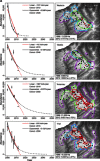Collapsing avian community on a Hawaiian island
- PMID: 27617287
- PMCID: PMC5014469
- DOI: 10.1126/sciadv.1600029
Collapsing avian community on a Hawaiian island
Abstract
The viability of many species has been jeopardized by numerous negative factors over the centuries, but climate change is predicted to accelerate and increase the pressure of many of these threats, leading to extinctions. The Hawaiian honeycreepers, famous for their spectacular adaptive radiation, are predicted to experience negative responses to climate change, given their susceptibility to introduced disease, the strong linkage of disease distribution to climatic conditions, and their current distribution. We document the rapid collapse of the native avifauna on the island of Kaua'i that corresponds to changes in climate and disease prevalence. Although multiple factors may be pressuring the community, we suggest that a tipping point has been crossed in which temperatures in forest habitats at high elevations have reached a threshold that facilitates the development of avian malaria and its vector throughout these species' ranges. Continued incursion of invasive weeds and non-native avian competitors may be facilitated by climate change and could also contribute to declines. If current rates of decline continue, we predict multiple extinctions in the coming decades. Kaua'i represents an early warning for the forest bird communities on the Maui and Hawai'i islands, as well as other species around the world that are trapped within a climatic space that is rapidly disappearing.
Keywords: Extinction; Hawai’i forest birds; Kaua’i island; climate change; conservation.
Figures


References
-
- G. C. Munro, Birds of Hawaii (Tongg Publishing Company, Honolulu, 1944).
-
- T. K. Pratt, C. T. Atkinson, P. C. Banko, J. D. Jacobi, B. L. Woodworth, Hawaiian Forest Birds: Their Biology and Conservation (Yale Univ. Press, New Haven, 2009).
-
- Atkinson C. T., LaPointe D. A., Introduced avian diseases, climate change, and the future of Hawaiian honeycreepers. J. Avian Med. Surg. 23, 53–63 (2009). - PubMed
-
- Warner R. E., The role of introduced diseases in the extinction of the endemic awaiian avifauna. Condor 70, 101–120 (1968).
-
- van Riper C. III, van Riper S. G., Goff M. L., Laird M., The epizootiology and ecological significance of malaria in Hawaiian land birds. Ecol. Monogr. 56, 327–344 (1986).
Publication types
MeSH terms
LinkOut - more resources
Full Text Sources
Other Literature Sources
Medical

